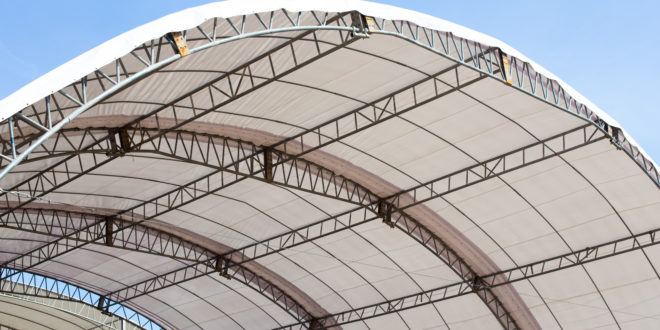Tension structures, also known as tensile fabric structures, are architecturally inventive forms of construction art that allow designers and end-users to create a range of free-form canopy patterns utilizing membranes.
Tensioned fabric structures are designed and built to comply with international structural, fire retardant, weatherproofing, and natural force standards. Fabric structures outperform traditional structures in terms of adaptability, strength, and portability. Several advantages of tensioned fabric structures include the following:
1. Allows Natural Light To Enter
Due to their transparency and the amount of natural light they allow in, choosing energy efficient fabric structure helps you save money on lighting and power. It’s an excellent option for anyone interested in building a greenhouse or other structure that requires a high amount of light and visibility on the inside.
Additionally, more excellent natural light enables fabric constructions to maintain a comfortable temperature in the winter and a cool temperature in the summer, using less energy to operate heating and cooling systems. Natural light has improved moods, workplace productivity, and sleep quality. All of these benefits accrue to laborers confined to isolated labor centers.
2. Provides Versatility
Designers, engineers, and architects can explore and develop novel ideas by incorporating a visually appealing and highly functional shading solution with tensile fabric structures. Apart from pioneering new design concepts, tensile shade structures can be employed for various applications.
Tensile fabric structures’ adaptability and functionality are ideal for several outdoor applications, including dining areas, paths, swimming pools, exhibits, sports stadiums, and warehouses. When designed and constructed appropriately, tensile structures can provide a range of benefits.
3. Reduces Installation Time
A fabric structure is far faster to design, fabricate, construct, and install than a traditional structure. Numerous fabric structures are pre-engineered, meaning that most engineering is completed before fabrication.
The architectural fabric is manufactured at the factory and transported in enormous panels to the construction site, allowing it to cover thousands of square feet simultaneously. Additionally, site tasks, including soil removal, pouring foundations and floor slabs, and erecting metal frames, can be accomplished concurrently with prefabricated panel fabrication.
4. Creates Visually Appealing Art

Architects, landscape architects, and designers value the opportunity to experiment with form and shape to produce unique ideas. You can transform even commonplace spaces into dynamic art shows by manipulating structures, layers, and graphics.
Additionally, these fantastic tensile constructions add usable space to the property for the benefit of its visitors. At night, lighting may impart a particular sheen on the membrane, further distinguishing it. When LED uplighting is used, the possibilities for creating truly unique designs are virtually unlimited.
5. Cost-Effective
Architectural fabric structures are frequently more cost-effective than rigid constructions when a prominent, clear span structure is required. The cost of a fabric structure varies by kind; pre-engineered frame structures and air-supported fabric structures are less expensive than custom-designed fabric structures.
The price depends on the architectural fabric selected, the amount of insulation installed, the type of lighting installed, and the type of HVAC system installed. When a conventional brick and mortar structure is of the same size as an architectural fabric structure, the fabric structure is always less expensive.
6. Low Maintenance
Tensile membrane structures are highly robust and resistant to adverse weather conditions. They outlast traditional roofs and don’t require additional materials or huge construction crews to maintain.
It’s particularly true in wilderness areas, where you must secure wildlife and minimize disturbance to the natural environment. Even in harsh settings with salt spray, chemicals, or blowing sand and debris, the complex, finely constructed tensile coverings of fabric buildings require little to no maintenance.
7. Safe And Durable
Due to a unique mix of design materials, construction, and environment, professionals use tensile membrane constructions worldwide to persist and withstand challenging and extreme climates and conditions.
Special corrosion-resistant and UV-safe coatings are applied to the tensioned cloth. Additionally, fabric structures are built to strict construction standards, allowing them to be securely erected in some of the world’s most inaccessible locations.
8. Allows Easy Changes
If your facilities are subject to frequent changes, fabric structures are more convenient than permanent, fixed constructions. Expandable fabric structures can be altered or updated to fit changing requirements.
Perhaps you’re considering adding a hot tub or pool to your property. In this situation, you can extend the structure of your fabric to accommodate coverage. Traditional designs must be removed and rebuilt to fit your new requirements, which is costly, inefficient, and unsustainable owing to increasing material use.
Takeaway
Lightweight building choices will become more popular as the worldwide movement toward sustainable construction gathers pace. When the benefits and range of potential constructions are considered, a tensioned fabric structure is an excellent substitute for a brick-and-mortar structure. It’s perfect for large groups seeking a controlled space to work, play, observe, and interact.


